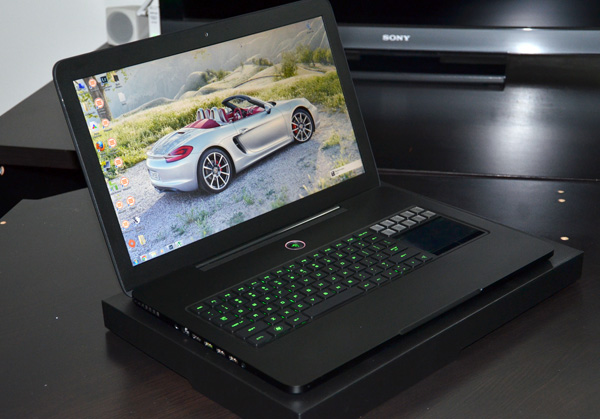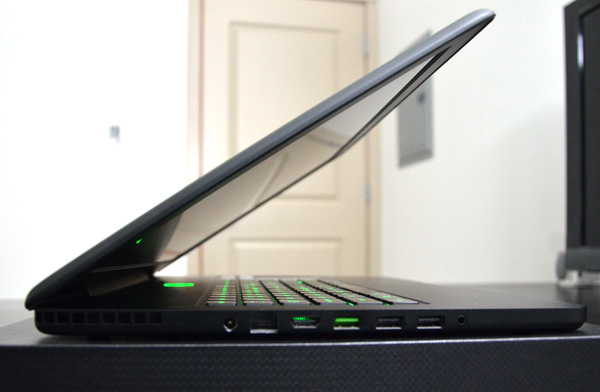The Razer Blade Review
by Vivek Gowri & Jarred Walton on March 15, 2012 3:01 AM ESTThere is something absolutely arresting about the Blade’s overall aesthetic. It’s big, but so strikingly thin at the same time, and the matte black paintjob is like a visual black hole. The overall effect is eye-catching, breathtaking, and will cause random passerby to stop and ask questions.
The design language is really, really clean and rather understated, two things you don’t expect from most gaming notebooks, while still keeping a sense of flair about it. The lid has two ribs vertically arranged on either side of the glowing Razer logo on the back, breaking up the monotony of the otherwise flat profile of the lid. Everything here is very uniformly laid out—lots of rectangles with radiused edges, no extraneous design elements, but unlike Apple’s portables, there’s no feeling of overwhelming sterility. Apple has taken the minimalist design philosophy so far that the MacBook Pro design language feels almost soulless.
The Blade doesn’t have that problem. The flat black aesthetic is offset by green accents—lots of them. The Razer logo on the back lights up in green, the power button has a Razer logo that glows green and pulsates almost like a heartbeat, the USB 3.0 port is green, the keys on the keyboard are green, a lot of the UI elements of the Switchlade panel are green, the list goes on. The industrial design is very clean, but what’s impressive is the overall polish in the design and how the whole thing ties together. It’s the little things—the attention to detail borders on obsessive, and that’s very good to see.
No matter what you think about the specs or the price, it’s impossible to ignore the fact that the Blade is a gorgeous, gorgeous device. It’s very obviously built to a high standard of build quality, with a machined aluminum unibody chassis that, even being so thin, is very structurally rigid. The lid and hinge are also pretty sturdy feeling, and the keyboard has no flex. Nothing about the look and feel of the Blade suggests anything less than a truly premium product.
In terms of ports, the Blade is pretty sparse. There’s one USB 3.0, two USB 2.0, HDMI, gigabit Ethernet, combo headphone jack/line in, and AC power all on the left side of the machine, as well as a Kensington lock on the right side. I’d definitely have liked to see an SD card slot here, along with one more USB 3.0 port, but given the form factor, you can understand why the Blade doesn’t have too much in the way of ports. The reason almost all the ports are on the left side is so that when at a desk using a mouse, gamers won’t ever run into the peripheral devices connected. Close to the back of the unit, there’s vents on either side; GPU on the right, CPU on the left.
The front is also completely clean, other than the angled cutout for opening the latch-less screen. The back of the system is dominated by the hinge, a right-angled piece that borrows from Apple’s playbook for designing low-profile hinges. The bottom of the system is also pretty minimalist, with chrome-ringed heat vents on the right and left sides, FCC information silk screened onto the body, and the Windows COA sticker. The heat vents are nice in that they are angled such that they blow air towards the rear of the notebook, away from the user.
The LCD bezel is thicker than I’d like, but the larger footprint was probably necessitated by the super-thin form factor. Above the display, we find the 2.0MP webcam, mic, and light sensor, while below it we find the highly stylised Blade logo rendered in glossy black. Against the metallic matte black of the rest of the interior, it’s understated yet incredibly cool looking.
The rest of the interior is pretty interesting. First things first, there’s no touchpad in the conventional sense—what happened, effectively, is that the touch-based input device got moved to where the keyboard’s number pad would be, leaving the area underneath the keyboard completely free. The keyboard and Switchblade are important enough to deserve their own page, but the rearranging of the touchpad enabled Razer to do some interesting things with the design. There’s much more space above the keyboard than you’d typically find on a notebook, something that Razer took advantage of by piping most of the heat generated by the CPU and GPU to that area. It’s not somewhere where people typically touch their computers, unlike the bottom or the palmrests, so engineering the thermal system to move heat towards the rear left corner was a good idea. Razer put vents on both sides of the Blade, but a majority of the heat is exhausted from the one on the left because the design team didn’t want hot air blowing on the mouse hand (when using an external mouse). It’s touches like this that impress—it’s rare to find this kind of polish or attention to detail in a company’s first computer.





















95 Comments
View All Comments
ezmo85 - Thursday, March 15, 2012 - link
This sort of reminds me of the launch of the original iPad:-very well built
-sleek and stylish
-extreme attention to and focus on optimization for use-case
-potential trend setter for a new category of computing
But there is one key difference that will prevent the Razer Blade from reaching anywhere near the iPad's success: pricing.
When the iPad launched, people were estimating it would land in the $1000+ range, which Apple very well could have done (especially given their record up to that point), dooming it to a small, niche market. Instead the pricing started at half that, and now 2 years later no one can deny its overwhelming success--even in the mainstream. In the case of the Razer Blade, I'm afraid this will remain a niche product until they can drastically lower the price.
I personally would love to own a Razer Blade; it would be the perfect compliment to my overpowered desktop. When I'm on the go I don't need the video settings cranked to the max, I just want the games to be playable, and the computer itself to be... well, a laptop. Something comfortable to carry around, with enough battery life to get me through a plane ride, coffee shop browsing session, class or two of note-taking, etc. This product meets that use case quite well, and I don't think I'm alone in these desires.
But there's no way I'm spending upwards of $3000 for this. Even on a higher-than-average salary, I just can't afford that. Cut that price by half... or even, dare I say, 2/3? At $1500, I'd be hard pressed not to at least make it a near-future purchase. At $1000, I'd buy it today (if the wife let me).
But I know those prices are pipe dreams... for now.
Anchen - Thursday, March 15, 2012 - link
Isn't this in a lot of ways like a Macbook pro, with some interesting design ideas? If this wasn't marketed as a "true gaming laptop" but just as a high end laptop I wonder what people's comments would be. Especially if say Apple was the one making these ideas. On a minor note, I would love the function key to be on the right side of my keyboard personally. I personally don't use it much , and if I do it's to fiddle with brightness, or to swap what the video is going out to. In other words it's something I don't mind digging a second for as opposed to touching by accident while gaming instead of ctrl.That said at it's price range it's not a product I'd buy, same for the macbook pro. Switchblade is neat but ultimately I think if they saved some money with a normal trackpad there they probably would have been better served. I really do like the design and aesthetic though.
Malih - Thursday, March 15, 2012 - link
I always wonder when there will ever be a 15" or 17" laptop with consumer-respecting display resolution that are THIN and have good design will come out. And here's one, it's gaming grade laptop too.I won't mind spending a bit over $2,500 for it (that is if I have the money to spare, which I don't right now, but if I do), I'd grab this laptop right away, that's how desirable it is... for me, cause I always respect a good display coupled with good design.
assmode - Thursday, March 15, 2012 - link
really, $2700 for this?a fancy lighted computer and a lcd touch pad.
sorry but that's a subpar computer with a low end graphics card, does it even have an SSD ?
Go with msi GT783, its got a nVidia GTX580m, 16gigs of ram and 256gb SSD in it atleast and for 500$ less.
assmode - Thursday, March 15, 2012 - link
and of course much better cpu.and going by the table here in the intro page, the GT780 is a much better deal than a lesser Alienware, lmao.
ThreeDee912 - Thursday, March 15, 2012 - link
People keep throwing out specs and prices, but the GT783 is over 2" thick and almost 9lbs.This isn't a desktop replacement, this is meant to actually be portable, not a semi-portable slab.
KoolAidMan1 - Thursday, March 15, 2012 - link
The 17" Macbook Pro costs less, has a faster GPU, all while still managing a slim chassis and excellent battery life.When a 17" MBP, a professional laptop that is excessive even among the Macbook Pro line, can beat the Razer Blade in specs and price then you know something is off.
Malih - Friday, March 16, 2012 - link
Now that I think about it, you're absolutely right. The only plus is the touchpad, which is not really a plus for me.ananduser - Friday, March 16, 2012 - link
No KooldAidMan, it's not about the specs, its the "experience"; you should understand that. MB cannot offer you what this Blade can, while the Blade can offer the mundane computing of a MB.ameetkumarmaharana - Thursday, March 15, 2012 - link
My budget is Rs.1,00,000 INR. Which laptop should I go for? Please suggest the best one within the price range.